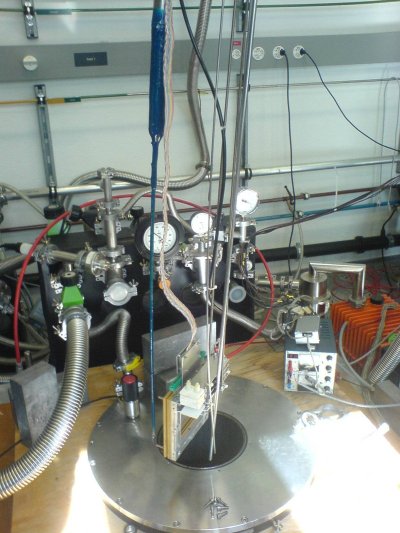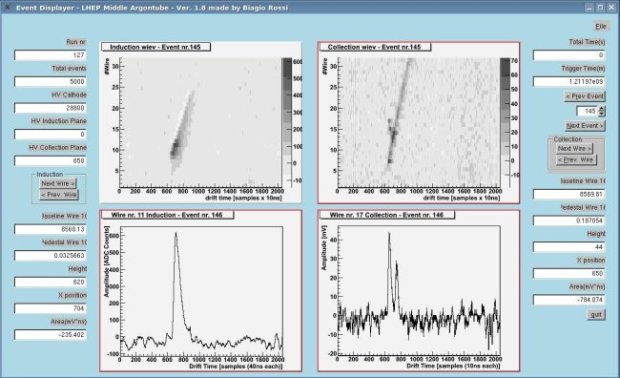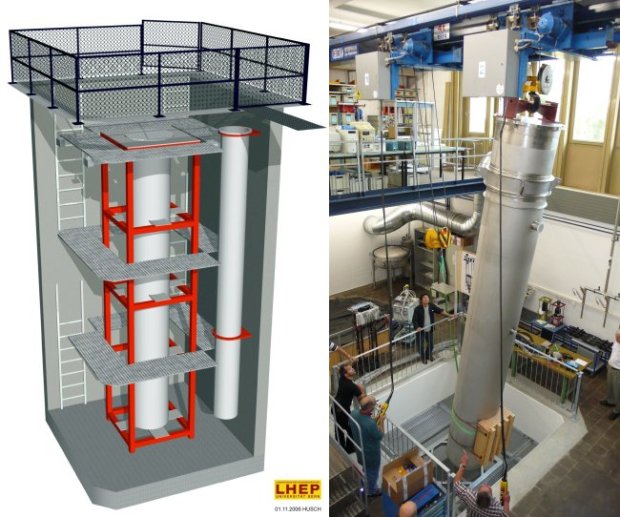Laboratory for High Energy Physics |

Cryogenic Noble Gas TPC
Members of the Bern group have large experience in the field of particle detectors. This includes knowledge on tracking devices, on calorimetry, on cryogenic detectors, on high-resolution emulsion films, on imaging detectors, etc. This motivates our interest in continuing along this line of research aiming at proposing, designing, realizing and operating powerful tools for future particle physics experiments.
The next generation of neutrino oscillation physics experiments calls for new detectors able to meet the challenge of the high intensity of the beam facilities (Super-beams, Beta-beams, Neutrino Factories) and also capable of improved particle identification and background rejection performance. The large mass of these detectors and their complexity will obviously imply important financial investments. This will make mandatory an appropriate and economical use of these facilities by extending their application to other fields, such as astroparticle physics and matter instability searches. The realization of these detectors will require a vigorous and coordinated effort of the community on the various R&D activities, as well as a wise exploitation of existing resources and infrastructure, seeking for complementarities among the different worldwide projects. In this respect we mention for example our EU approved LAGUNA project whose main aim is a critical exploration and comparison for possible underground sites suitable to host the large-mass, envisioned detectors.
In particular, the detection technique of the liquid Argon Time Projection Chambers (LAr TPC) is well suited to answer the demanding experimental requirements originating from the above considerations. The Bern group has been and is presently very active in proposing a global research strategy centered on both the design and proposal of experiments exploiting this technique and on the related R&D strategy. A complete and relatively exhaustive R&D program has been identified for several key issues. Interesting results have already been obtained, more projects are under way, and others are planned for the next future. The experience gathered so far by LHEP should allow pursuing the above studies centered on LAr TPC prototypes to be realized and operated. In particular, for the near future, the Bern group intends to strongly pursue the following activities:
- realization and operation in the LHEP laboratory of ARGONTUBE, a 5 m long LAr TPC detector for the study of long electron drift-path and new read-out devices, as required for future large-mass applications of the technique;
- realization of small size prototype LAr TPCs for specific detector technology studies;
- development of new read-out electronics tailored to LAr TPCs in view of future large scale applications.
LAr TPCs allow for a uniform and high accuracy imaging of massive detector volumes. The operating principle is based on the fact that in highly purified LAr tracks produced by the passage of charged particles through the volume of the detector (basically a large parallel plate capacitor, where the dielectric medium is liquid Argon) could be transported undistorted by a uniform electric field over distances of the order of meters. The purity of the liquid is a very important aspect, since long drift distances require contamination from Oxygen or other electro-negative impurities at the level of 0.1 ppb or better. This purity is nowadays routinely achieved thanks to the use of gaseous and liquid re-circulation and purification through industrial Oxygen-absorbing cartridges.
Imaging is provided by electrodes (e.g. wire planes or other novel signal amplifying devices such GEM or LEM) placed at the end of the drift path, continuously sensing and recording the signals induced by the drifting electrons. Liquid Argon is an ideal medium since it provides high-density, high ionization and scintillation yields, and is intrinsically safe and cheap. The read-out of ionization electrons by charge induction allows detecting the signal of electrons crossing e.g. subsequent detector planes with different orientation. This provides several projective views of the same event, hence allowing for space point reconstruction and precise calorimetric measurement. The particle momentum can be inferred via a multiple scattering measurement, while the detection of the local energy deposition (dE/dx) can provide e/p0 separation and particle identification through a range versus dE/dx measurement. The total energy reconstruction of the event is performed by charge integration within the detector volume, the detector being a full-sampling, homogenous calorimeter.
As mentioned above, at LHEP-Bern we are presently working on three main detectors:
- a small detector (a few cubic centimeters) for the study of basic properties of the technique and for possible application to other fields as e.g. security;
- a medium-size device of about 20 liters active volume;
- a very large detector (7m in length), the ARGONTUBE, for the study of large-scale equipment (cryogenics, purification, etc.) and in particular for the study of long drift path.

The first small size prototype assembled in 2007 consists of a small wire chamber made of a Vetronite support. 10 Cu-Be wires of 125 micrometer diameter are mounted on the support opposite to a cathode plane. The operating electric field ranges from 500-2000 V/cm along a drift space of almost 1 cm, and for an active volume of 10 x 10 x 1 cm3. Even higher field values of up to 10000 V/cm can be obtained if required by specific studies. Standard purification systems have been used for the filling-in while we did not use any re-circulation system. The Figures below shows a detail of the wire chamber with its ancillary vacuum and filling systems. We have recently got interesting results by filling the chamber with a mixture of LAr and LN.
The medium size detector consists of an inner detector with the TPC in highly pure LAr located in a dewar filled with LAr. The TPC is composed of a cathode placed at the tube bottom-end, where a photomultiplier is also installed, immersed in the liquid Argon, in order to collect the UV scintillation-light produced by ionizing particles in addition to the ionization signal. Field-shaping electrodes placed around the vessel?s inner surface drive the ionization electrons to the anode, positioned at the top-end of the vessel, where the read-out device is installed. We are considering (and studying) for that several options: wire chambers, GEM or LEM detectors.
The main purpose of the medium-size Bern LAr TPC detector is the study of 1) suitable readout devices, 2) the HV generator system (Greinacher), 3) the multi-photonic UV laser ionization of LAr, 4) the recirculation filtering system for LAr to reach the required purity. As far as point 3) is concerned, we stress that UV laser beams are particularly attractive as a novel method to perform the calibration of LAr detectors and the on-line measurement of the liquid purity, as mentioned above, an essential parameter to be monitored for a correct operation of the device. Laser beams induce tracks in the detector analogous to those produced by minimum ionizing particles, but not affected like those by multiple Coulomb scattering, Landau fluctuations, and for which the position and the timing can be known a priori. Preliminary studies have indicated the principle feasibility of the method. More R&D activities will be devoted in Bern to a deeper understanding of the process and to the realization of actual systems for use in the future full scale detectors. The medium-size detector has been fully realized, assembled and commissioned with cosmic ray and radioactive source data taking, as shown in the Figures below.


The realization of a ~5 m long-drift LAr TPC (ARGONTUBE) being conducted in collaboration with ETHZ and Univ. Granada, is a required step to experimentally prove the feasibility of LAr TPC detectors with very long drift path, a fundamental milestone towards the design of the future large mass devices. The device is composed of a custom ~6 m long, 80 cm diameter dewar vessel housing a ~5 m long prototype LAr detector. The inner detector is composed of a cathode placed at the tube bottom-end, where a photomultiplier is also installed, immersed in the liquid Argon, in order to collect the UV scintillation-light produced by ionizing particles in addition to the ionization signal. Field-shaping electrodes placed around the vessel inner-surface drive the ionization electrons to the anode, positioned at the top-end of the vessel, where the read-out device is installed. We are considering for that several options: wire chambers, GEM or LEM detectors. The upper part of ARGONTUBE is closed by a flange housing feedthroughs to connect to the internal instrumentation, valves and other cryogenics and electronics equipment. The system is complemented with LAr filling lines through purification cartridges, a liquid re-circulation system, monitoring devices, etc.
The device will be installed and run at LHEP Bern. Given the dimensions and the complexity of the detector, we plan to install the device in our Grosslabor, for which we have already completed the civil engineering work and realized the ~ 7 m deep pit to house the cryogenic vessel and to allow the pulling-up of the inner detector. The Figures below show an artistic view of the ARGONTUBE detector and a photograph of the external dewar while being installed.

